Survey or Interview中澤 学
臨床と研究という文武両道で
ハートチームを盛り上げていく
Clinical excellence and research strength— Driving the heart team forward.
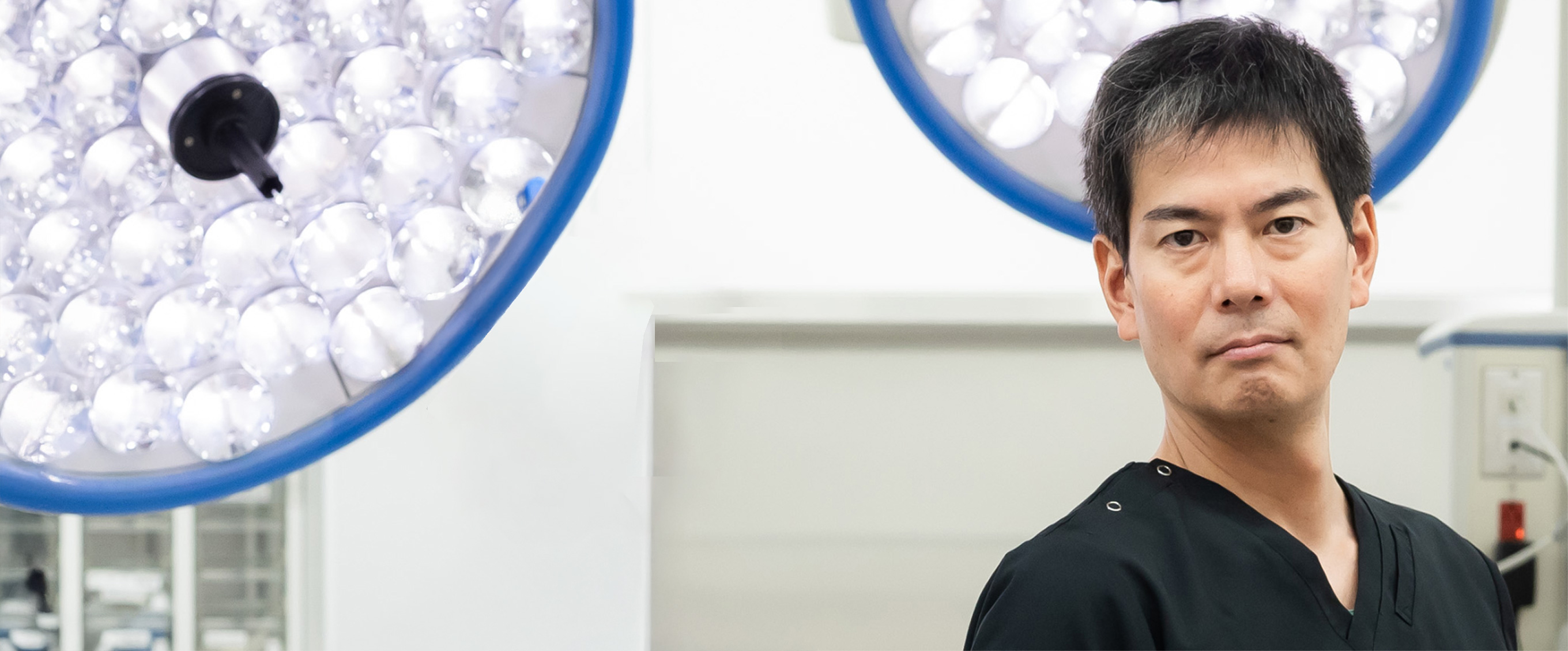
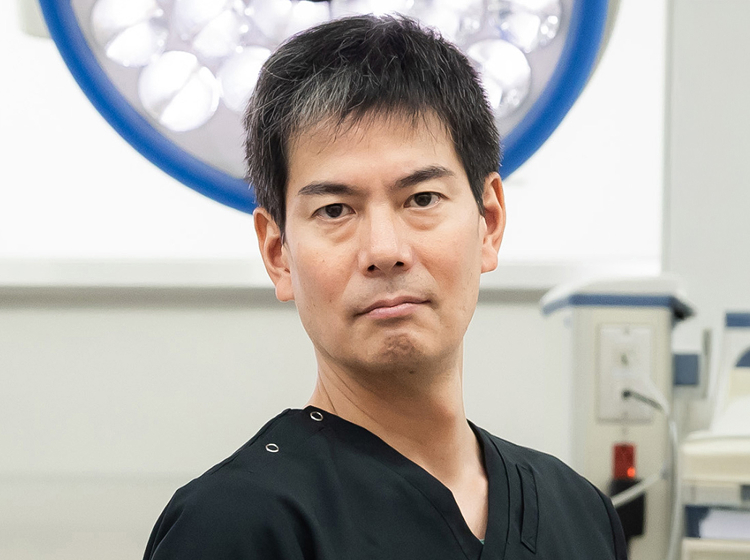
中澤 学
Interview
NAKAZAWA Gaku
内科学教室(循環器内科部門)主任教授
Chief Professor of Department of Cardiology
2019年のある日のことだった。
東海大学医学部循環器内科学の准教授だった中澤学が、いつものようにパソコンを開くと、面識のない人間からのメールが目に付いた。差し出し人は、近畿大学医学部心臓血管外科教授の坂口元一、近畿大学医学部の教授選がある、興味はないかという内容だった。
「怪しいメールだと思いました」と中澤は冗談っぽく笑う。
「坂口先生をどこかでお見かけした記憶はありましたが、直接の付き合いはありませんでした。坂口先生ってどんな人ですかと仲間に聞いたら、すごくいい先生だと」
坂口に連絡をとってみると、関東にいる信頼している心臓外科医が中澤を推薦したという。評価されたことは嬉しかった。しかし、東京で育った中澤にとって近畿大学のある関西はこれまで全く縁がなかった。そして、今の環境にも不満はない。いや、恵まれすぎているほどだった。
「一度、ご飯でも食べましょうということで、坂口先生と夕食をとるため大阪へ日帰りで行ったんです」
中澤がアメリカの「CVPath Instisute,inc.」から東海大学医学部に循環器内科学助教として入局したのは、2009年のことだ。帰国する際、東海大学ならば臨床と病理のどちらも出来ると誘われたのだ。
「臨床と研究、いわば文武両道をぼくはやりたかった。東海大学では、助教であっても研究室を立ち上げて、研究資金を集めることができるというシステムだったんです。そこで自分で病理ラボ(研究室)を立ち上げました。アメリカで書いた論文が評価されて、様々な企業から研究が持ち込まれるようになっていました。その研究資金の中で人を雇い、ラボ(研究室)を大きくしていました。循環器内科学の教授である伊苅裕二先生は自由にやらせてくださった。後輩たちもぼくのことを慕ってくれて、手足のように動いてくれていた。東海大学で何も困っていなかったんです」
振り返れば、東海大学では、ゼロからのスタートだった。自分のやりたいことができるようになり、道を切り拓いていたという自負と同時に、最近、ぬるま湯に浸かっているとはっとすることもあった。知り合いのいない関西に行くのもいいかもしれない。近畿大学という像が彼の中で大きくなっていった。
東海大学医学部循環器内科学の准教授だった中澤学が、いつものようにパソコンを開くと、面識のない人間からのメールが目に付いた。差し出し人は、近畿大学医学部心臓血管外科教授の坂口元一、近畿大学医学部の教授選がある、興味はないかという内容だった。
「怪しいメールだと思いました」と中澤は冗談っぽく笑う。
「坂口先生をどこかでお見かけした記憶はありましたが、直接の付き合いはありませんでした。坂口先生ってどんな人ですかと仲間に聞いたら、すごくいい先生だと」
坂口に連絡をとってみると、関東にいる信頼している心臓外科医が中澤を推薦したという。評価されたことは嬉しかった。しかし、東京で育った中澤にとって近畿大学のある関西はこれまで全く縁がなかった。そして、今の環境にも不満はない。いや、恵まれすぎているほどだった。
「一度、ご飯でも食べましょうということで、坂口先生と夕食をとるため大阪へ日帰りで行ったんです」
中澤がアメリカの「CVPath Instisute,inc.」から東海大学医学部に循環器内科学助教として入局したのは、2009年のことだ。帰国する際、東海大学ならば臨床と病理のどちらも出来ると誘われたのだ。
「臨床と研究、いわば文武両道をぼくはやりたかった。東海大学では、助教であっても研究室を立ち上げて、研究資金を集めることができるというシステムだったんです。そこで自分で病理ラボ(研究室)を立ち上げました。アメリカで書いた論文が評価されて、様々な企業から研究が持ち込まれるようになっていました。その研究資金の中で人を雇い、ラボ(研究室)を大きくしていました。循環器内科学の教授である伊苅裕二先生は自由にやらせてくださった。後輩たちもぼくのことを慕ってくれて、手足のように動いてくれていた。東海大学で何も困っていなかったんです」
振り返れば、東海大学では、ゼロからのスタートだった。自分のやりたいことができるようになり、道を切り拓いていたという自負と同時に、最近、ぬるま湯に浸かっているとはっとすることもあった。知り合いのいない関西に行くのもいいかもしれない。近畿大学という像が彼の中で大きくなっていった。
A passionate cardiologist who masters both ‘clinical excellence and research strength.
It was on an ordinary day in 2019 when NAKAZAWA Gaku, then an associate professor of cardiology at Tokai University School of Medicine, opened his computer and noticed an unfamiliar email. The sender was SAKAGUCHI Genichi, professor and chair of cardiovascular surgery at Kindai University Faculty of Medicine. The message said there would be an upcoming faculty recruitment for the chair of cardiology—and asked if he might be interested.“At first, I thought it might be a suspicious email,” NAKAZAWA said with a wry smile.
“I vaguely recalled having seen Professor SAKAGUCHI somewhere, but I had never had any direct connection with him. When I asked colleagues what kind of person he was, they all said, ‘He’s a really good doctor.’”
When NAKAZAWA reached out, SAKAGUCHI explained that a trusted cardiovascular surgeon in the Kanto region had personally recommended him. NAKAZAWA was flattered to be so highly regarded, but also hesitant. Born and raised in Tokyo, he had no ties at all to Kansai, where Kindai University is located. In fact, he had no dissatisfaction with his current position, and in truth, he had no complaints about his current environment. On the contrary, he felt almost overly fortunate.
“Still, Professor SAKAGUCHI suggested we meet over dinner. So, I decided to make a quick day trip to Osaka just to have that meal with him.”
NAKAZAWA joined the Department of Cardiology at Tokai University School of Medicine as an assistant professor in 2009, after returning from the CVPath Institute, Inc. in the United States. When he was preparing to return to Japan, Tokai University had approached him with a unique offer: there, he could pursue both clinical practice and pathology research.
“I wanted to do both—the clinical side and the research side, like mastering both the arts and the sciences. At Tokai, even as an assistant professor, the system allowed me to establish my own laboratory and secure my own research funding. So, I set up a pathology lab from scratch. The papers I had written in the United States were well received, and companies began bringing research projects to me. With those funds, I was able to hire people and expand the lab. Professor IKARI Yuji, who chaired the Department of Cardiology, gave me complete freedom. The younger doctors looked up to me and worked alongside me like extra hands. Honestly, I lacked for nothing at Tokai,” he says.
Looking back, NAKAZAWA recognizes that it had been a journey from zero at Tokai University —building a place where he could do exactly what he wanted, carving out his own path. Yet at times, he would catch himself wondering if he had grown too comfortable in that success. Perhaps, he thought, moving to Kansai, where he knew no one, might be a good thing.
Gradually, the idea of Kindai University began to loom larger in his mind.
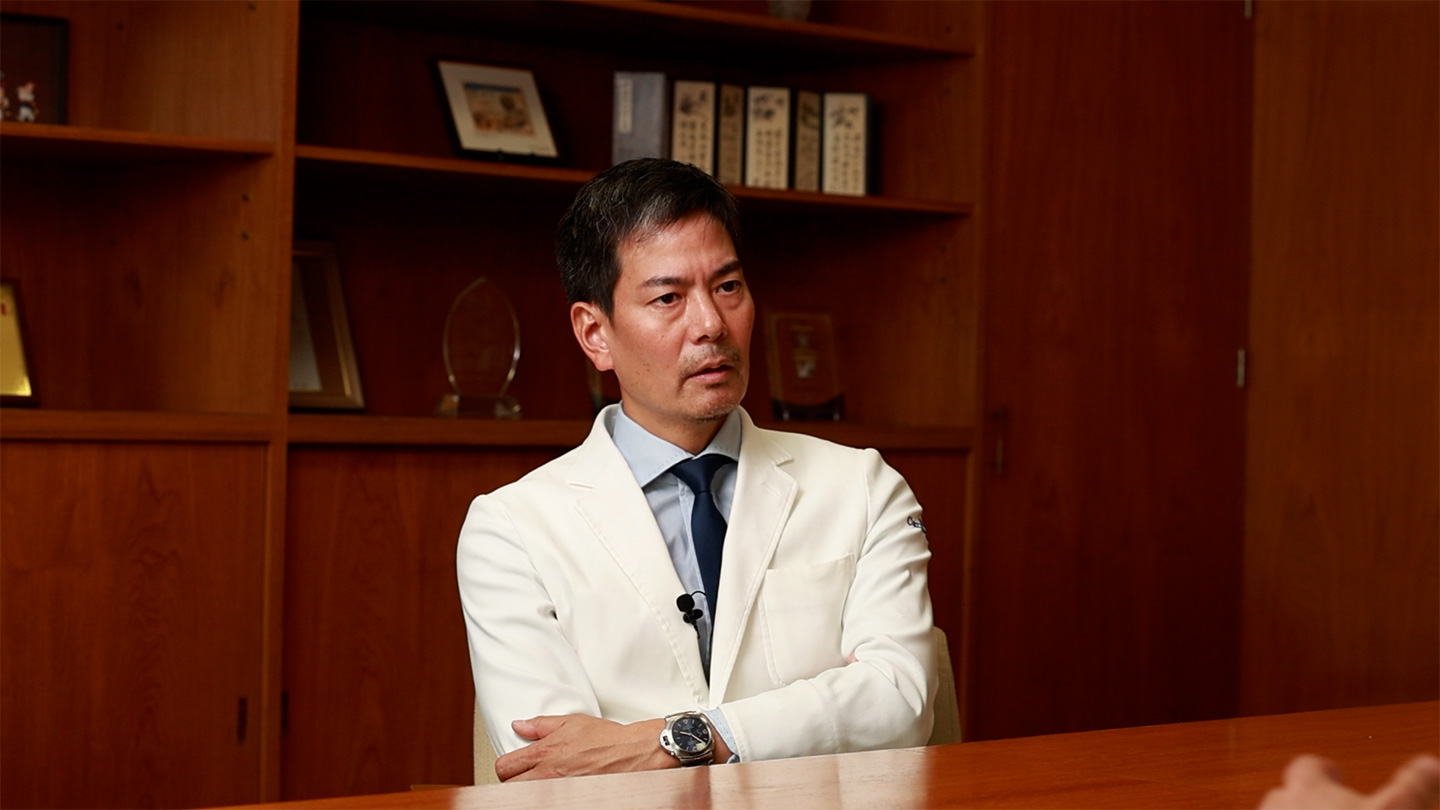
中澤は1974年にアメリカで生まれた。小児科医である父親の留学中だった。
帰国後、東京の名門校である武蔵中学に入学するが、中学生、高校生時代を通して、バスケットボール部と友達との遊びで、勉強は二の次だったと頭をかく。そして東邦大学医学部に進学する。
「進路について何も考えていない高校生活でした。父親も医者だし、面白そうだし、みたいな感じで安易に選んだ感じです」
医学部入学後も、中澤曰く「真面目とは言い難い」学生生活がしばらく続いたという。転機が訪れたのは5年生の実習が始まった頃だった。
「医学とか患者さんへの向き合い方に興味が湧いて、勉強し始めたら面白いなと。そこから勉強を頑張りましたね。6年生のときには同級生に教えられるぐらいになっていて、国家試験も落ちるわけないな、と」
専門として循環器内科を選んだのは「心臓のテンポ、スピード感が自分に合っている」と思ったからだ。小児科医でもあった父親も心臓を得意としていたことが、頭のどこかにあったのかもしれない。
循環器内科でカテーテル治療が盛んに行われるようになったことも彼の背中を押した。
カテーテル手術とは、足の付根にある大腿動脈という血管からカテーテルと呼ばれる細い管を入れて心臓まで通し、血管内から治療を行う。外科的な手術よりも体への負担が少なく、術後の回復が早く、合併症のリスクが低い。
しばしば、外科医=体育会系、内科医=文化系という色分けをされる。
「研修で内科を回っていると良く“外科っぽいよね、なんで内科に来たの”と言われてました。でも結果的に、循環器内科、カテーテル手術はほぼ外科のような仕事でした」
東邦大学医学部卒業後、東京大学附属病院のレジデントを1年務めた後、三井記念病院に移る。
「三井記念病院は循環器内科で有名だったこと。ぼく自身、24時間365日働くような、忙しくバリバリ仕事が出来る病院に行きたかった。三井記念病院はまさにそういう病院だったんです」
朝は7時には病院に着く。そして終わりは23時、あるいは日付が変わっていた。
「22時に終わったら早いねって、飲みに行っていました。2時ぐらいまで飲んで、みんなで病院に戻って雑魚寝して、朝から働くみたいな。とにかく色んな症例を経験したいという一心で病院にへばりついている人間ばかりでした」
三井記念病院では1人の患者に1人の医師が担当することが基本だった。
「患者さんが重症でECMO(エクモ)をつけている場合は、当直医に任すことはできない。ICU(集中治療室)で患者さんの隣りのベッドが空いていればそこで仮眠をとって、1週間泊まり込むなんてこともありました。担当以外でも重症患者が入ったら、自分以外の人間が経験を積むのが悔しくて、一緒に見させてくれとみんながついていく」
循環器内科の仕事は「じっくりかけて100点を取るのではなく、短時間で70点取らねばならない」と思うようになった。
「また次に助けなきゃいけない人がやってくる。素早く70点まで持って行き、100点まで持って行くのは後でもいい。心臓が停まって5分以内に何ができるのか。20分考えて、答えをみつけたとしても、そのときには患者さんは亡くなっている。100メートル走を走りながら将棋の問題を解いているみたいな感じです」
仲間と切磋琢磨する楽しくも怒濤の日々も終わりが来る。当時の三井記念病院では5、6年経つと、次のステップに進むのが一般的だった。
「東大の大学院には合格していたんです。自分が得意なのはスピード感を持って患者さんと接すること。試験管振って研究をするというフィールドに自分が出て、東大の人たちと互角以上に戦えるか。ただ、臨床を深めるために研究をしなければならないという意識はありました。そこで、誰も行っていないところに留学しようと模索し始めたのが、5年目でした」
中澤が選んだのは、アメリカ・メリーランド州ゲイザースバーグにあるCVPathだった。CVPathには心臓血管病理の世界的権威、レヌ・ヴィルマーニがいたのだ。2006年7月、中澤はゲイザースバーグに向かった。人口70000人に届かない小さな街である。
「英語ができるようになりたいと思っていました。だから日本人がいなくて、英語が上手くなるしかないという環境を選びました。行ってから最初は英語が出来なさすぎて、本当に苦労しました。3年目になって英語が本当に伸びましたね」
中澤はヴィルマーニの元で薬剤用ステントの病理変化の研究を進めた。ヴィルマーニからは研究だけでなく、自分の信念を守る大切さも学んだ。
「彼女は絶対に自分の意見を曲げなかった。白も黒に変えてしまうぐらいのレベルの人。研究の現場では、そうした強さが時に必要になる」
中澤の論文は高い評価を受け、ヴィルマーニからは研究所に残るように薦められた。またアメリカ国内の医療機関からも誘いがあった。しかし、中澤は日本に帰ることにした。
「研究をした理由は、臨床の第一線でやりたいからだったんです。臨床の第一線、トップの病院で治療を出来る条件は研究も出来る人であること。臨床と研究という文武両道です。患者さんと向き合う診療がぼくのキャリアの目標でした。研究で思いのほか成果があがってしまった。アメリカに居つづけようかと一瞬迷いました。でもアメリカに残ると臨床ができない」
熱心な誘いがあった東海大学医学部循環器内科学助教として日本に帰国したのが、2009年。近畿大学の坂口から連絡が来たのが2019年。日本に帰国して10年経っていた。「居心地が良くなると、自分の伸び率が悪くなる」と考えた、中澤は近畿大学の教授に応募することにした。
2020年1月、中澤は近畿大学医学部循環器内科主任教授に就任した。
帰国後、東京の名門校である武蔵中学に入学するが、中学生、高校生時代を通して、バスケットボール部と友達との遊びで、勉強は二の次だったと頭をかく。そして東邦大学医学部に進学する。
「進路について何も考えていない高校生活でした。父親も医者だし、面白そうだし、みたいな感じで安易に選んだ感じです」
医学部入学後も、中澤曰く「真面目とは言い難い」学生生活がしばらく続いたという。転機が訪れたのは5年生の実習が始まった頃だった。
「医学とか患者さんへの向き合い方に興味が湧いて、勉強し始めたら面白いなと。そこから勉強を頑張りましたね。6年生のときには同級生に教えられるぐらいになっていて、国家試験も落ちるわけないな、と」
専門として循環器内科を選んだのは「心臓のテンポ、スピード感が自分に合っている」と思ったからだ。小児科医でもあった父親も心臓を得意としていたことが、頭のどこかにあったのかもしれない。
循環器内科でカテーテル治療が盛んに行われるようになったことも彼の背中を押した。
カテーテル手術とは、足の付根にある大腿動脈という血管からカテーテルと呼ばれる細い管を入れて心臓まで通し、血管内から治療を行う。外科的な手術よりも体への負担が少なく、術後の回復が早く、合併症のリスクが低い。
しばしば、外科医=体育会系、内科医=文化系という色分けをされる。
「研修で内科を回っていると良く“外科っぽいよね、なんで内科に来たの”と言われてました。でも結果的に、循環器内科、カテーテル手術はほぼ外科のような仕事でした」
東邦大学医学部卒業後、東京大学附属病院のレジデントを1年務めた後、三井記念病院に移る。
「三井記念病院は循環器内科で有名だったこと。ぼく自身、24時間365日働くような、忙しくバリバリ仕事が出来る病院に行きたかった。三井記念病院はまさにそういう病院だったんです」
朝は7時には病院に着く。そして終わりは23時、あるいは日付が変わっていた。
「22時に終わったら早いねって、飲みに行っていました。2時ぐらいまで飲んで、みんなで病院に戻って雑魚寝して、朝から働くみたいな。とにかく色んな症例を経験したいという一心で病院にへばりついている人間ばかりでした」
三井記念病院では1人の患者に1人の医師が担当することが基本だった。
「患者さんが重症でECMO(エクモ)をつけている場合は、当直医に任すことはできない。ICU(集中治療室)で患者さんの隣りのベッドが空いていればそこで仮眠をとって、1週間泊まり込むなんてこともありました。担当以外でも重症患者が入ったら、自分以外の人間が経験を積むのが悔しくて、一緒に見させてくれとみんながついていく」
循環器内科の仕事は「じっくりかけて100点を取るのではなく、短時間で70点取らねばならない」と思うようになった。
「また次に助けなきゃいけない人がやってくる。素早く70点まで持って行き、100点まで持って行くのは後でもいい。心臓が停まって5分以内に何ができるのか。20分考えて、答えをみつけたとしても、そのときには患者さんは亡くなっている。100メートル走を走りながら将棋の問題を解いているみたいな感じです」
仲間と切磋琢磨する楽しくも怒濤の日々も終わりが来る。当時の三井記念病院では5、6年経つと、次のステップに進むのが一般的だった。
「東大の大学院には合格していたんです。自分が得意なのはスピード感を持って患者さんと接すること。試験管振って研究をするというフィールドに自分が出て、東大の人たちと互角以上に戦えるか。ただ、臨床を深めるために研究をしなければならないという意識はありました。そこで、誰も行っていないところに留学しようと模索し始めたのが、5年目でした」
中澤が選んだのは、アメリカ・メリーランド州ゲイザースバーグにあるCVPathだった。CVPathには心臓血管病理の世界的権威、レヌ・ヴィルマーニがいたのだ。2006年7月、中澤はゲイザースバーグに向かった。人口70000人に届かない小さな街である。
「英語ができるようになりたいと思っていました。だから日本人がいなくて、英語が上手くなるしかないという環境を選びました。行ってから最初は英語が出来なさすぎて、本当に苦労しました。3年目になって英語が本当に伸びましたね」
中澤はヴィルマーニの元で薬剤用ステントの病理変化の研究を進めた。ヴィルマーニからは研究だけでなく、自分の信念を守る大切さも学んだ。
「彼女は絶対に自分の意見を曲げなかった。白も黒に変えてしまうぐらいのレベルの人。研究の現場では、そうした強さが時に必要になる」
中澤の論文は高い評価を受け、ヴィルマーニからは研究所に残るように薦められた。またアメリカ国内の医療機関からも誘いがあった。しかし、中澤は日本に帰ることにした。
「研究をした理由は、臨床の第一線でやりたいからだったんです。臨床の第一線、トップの病院で治療を出来る条件は研究も出来る人であること。臨床と研究という文武両道です。患者さんと向き合う診療がぼくのキャリアの目標でした。研究で思いのほか成果があがってしまった。アメリカに居つづけようかと一瞬迷いました。でもアメリカに残ると臨床ができない」
熱心な誘いがあった東海大学医学部循環器内科学助教として日本に帰国したのが、2009年。近畿大学の坂口から連絡が来たのが2019年。日本に帰国して10年経っていた。「居心地が良くなると、自分の伸び率が悪くなる」と考えた、中澤は近畿大学の教授に応募することにした。
2020年1月、中澤は近畿大学医学部循環器内科主任教授に就任した。
“You look like the surgical type. So why internal medicine?”
NAKAZAWA Gaku was born in 1974 in the United States while his father, a pediatrician, was studying abroad.After the family returned to Japan, he enrolled at Musashi Junior High School in Tokyo, one of Tokyo’s elite schools. But throughout his middle and high school years, basketball practice and hanging out with friends always took precedence over studying. With a sheepish scratch of his head, he admits that academics came second. Even so, he advanced to the Faculty of Medicine at Toho University.
“In high school, I hadn’t really thought about my future at all. My father was a doctor, and I thought, well, maybe it could be interesting—that was about the extent of my reasoning,” he says.
Even after entering medical school, NAKAZAWA says his life as a student was anything but “serious” for a while. The turning point came in his fifth year, when clinical training began.
“That’s when I started to take an interest in medicine itself, and how doctors relate to patients. Once I began studying, I found it fascinating. From then on, I really applied myself. By the sixth year, I was good enough to teach my classmates. At that point, I thought, there’s no way I’ll fail the national licensing exam.”
He chose cardiology as his specialty because, as he puts it, “the tempo and speed of the heart just suited me.” Another factor was perhaps the fact that his father, though a pediatrician, had also specialized in cardiac care.
Another reason was the rapid rise of catheter-based procedures in cardiology. Catheter surgery involves inserting a thin tube called a catheter through the femoral artery in the groin and guiding it up to the heart, where treatment is carried out from inside the blood vessels. Compared with open surgery, it places less strain on the body, allows for faster recovery, and carries a lower risk of complications.
Cardiologists are often seen as the “cultural types” of medicine, while surgeons are cast as the “athletic types.” NAKAZAWA remembers how this perception followed him early on.
“During my training rotations in internal medicine, people would often say, ‘You seem more like a surgeon. Why are you here in internal medicine?’ But in the end, interventional cardiology and catheter-based surgery turned out to be almost like surgery anyway.”
After graduating from the Toho University Faculty of Medicine, NAKAZAWA spent a year as a resident at the University of Tokyo Hospital before moving to Mitsui Memorial Hospital.
“Mitsui Memorial was renowned for its cardiology department. Personally, I wanted to be in a place where I could work flat-out, twenty-four hours a day, three hundred sixty-five days a year. Mitsui Memorial was exactly that kind of hospital.”
Days began at 7:00 a.m. and often didn’t end until 11:00 p.m. or even after midnight.
“If we finished by 10 p.m., we thought of it as an early night. We’d go out drinking until about 2 a.m., then head back to the hospital, crash on the floor, and start work again in the morning. Everyone there was glued to the hospital, driven purely by the desire to experience as many cases as possible.”
At Mitsui Memorial Hospital, the principle was simple: one physician took full responsibility for one patient.
“If a patient was critically ill and on ECMO, you couldn’t just hand them over to the on-duty doctor. If there was an empty bed beside the patient in the ICU, I would take naps there, sometimes staying for an entire week. Even when it wasn’t my assigned patient, if someone in critical condition was admitted, I couldn’t stand the thought of others gaining that experience while I missed out. Everyone would come in, saying, ‘Let me observe too.’”
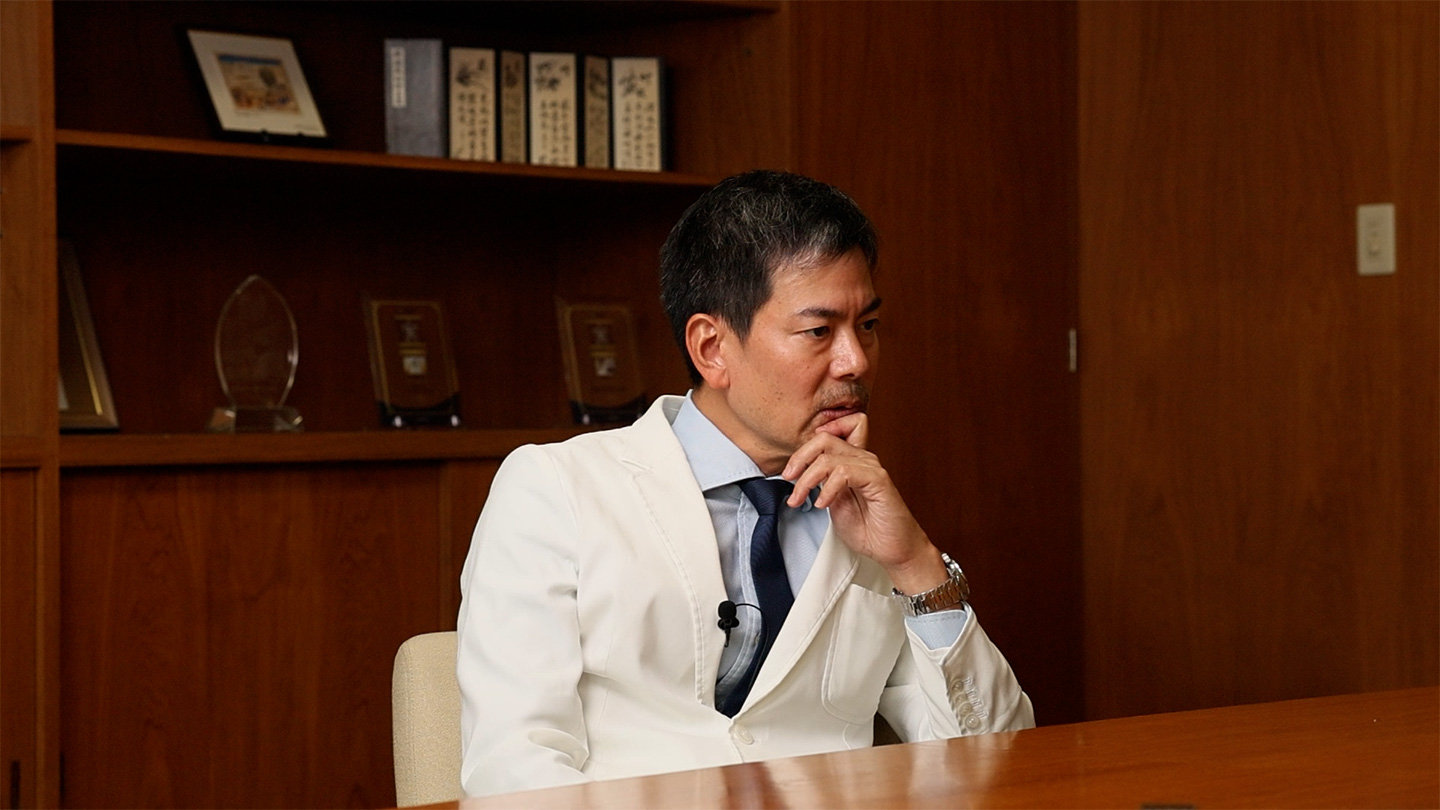
近畿大学医学部の第一印象は「みんな人がいい」というものだった。
「まずは診療を盛り上げてほしいと言われました。常にぼくがカンファレンスなどで言っているのは、患者さんが一番だと言うこと。自分たちの功名心のために医療をしてはならない」
近年、循環器疾患、特に心臓の疾患について「ハートチーム」という言葉が良く使われる。冠動脈疾患、心臓弁膜症、大動脈疾患など心臓周りの疾患には、多くの治療選択肢がある。カテーテル治療(PCI、TAVI/TAVR)、内科的治療、薬物療法など、患者の状況に応じて最適解を探る必要がある。循環器内科医と心臓外科医、そして、麻酔科医、放射線科医、看護師、リハビリスタッフなどチームを組み、密接にコミュニケーションをとる。近畿大学でハートチームの中心となるのは、中澤と彼を誘った心臓血管外科を率いる坂口だ。坂口とは今もいい関係だ。
「心臓血管外科医の数って少ない上、どんどん減っている。(外科)手術が出来る人間がいないと、ぼくたち、そして患者さんが困る。心臓血管外科医が肉体的、精神的に健康であることは非常に大事。そこで、2025年から心臓血管外科医の当直を免除にして、ぼくたち循環器内科医がカバーすることにしました。緊急手術のときは、彼らが夜を徹して手術をすることもある。持ちつ持たれつ、の関係なんです」
2021年から中澤は、救急災害センター長を2期務めている。不在だった救急医学教室の教授として中澤が招聘したのが、現・主任教授の篠崎広一郎だ。今度は中澤は人を辿って篠崎に声を掛けたのだ。
知り合いもほとんどおらず、地縁もなかった大阪の地がホームになりつつあると中澤は感じることがある。
「現在、ぼくは副病院長もさせてもらっています。新病院に移転しますし、近畿大学のブランド力があがるように、チームビルディングしていかなきゃいけないと考えています」
中澤のポリシーは、今、目の前にある課題、目標に向かって突き進むことだ。彼か常に前向きに未来を見据えているのだ。
「まずは診療を盛り上げてほしいと言われました。常にぼくがカンファレンスなどで言っているのは、患者さんが一番だと言うこと。自分たちの功名心のために医療をしてはならない」
近年、循環器疾患、特に心臓の疾患について「ハートチーム」という言葉が良く使われる。冠動脈疾患、心臓弁膜症、大動脈疾患など心臓周りの疾患には、多くの治療選択肢がある。カテーテル治療(PCI、TAVI/TAVR)、内科的治療、薬物療法など、患者の状況に応じて最適解を探る必要がある。循環器内科医と心臓外科医、そして、麻酔科医、放射線科医、看護師、リハビリスタッフなどチームを組み、密接にコミュニケーションをとる。近畿大学でハートチームの中心となるのは、中澤と彼を誘った心臓血管外科を率いる坂口だ。坂口とは今もいい関係だ。
「心臓血管外科医の数って少ない上、どんどん減っている。(外科)手術が出来る人間がいないと、ぼくたち、そして患者さんが困る。心臓血管外科医が肉体的、精神的に健康であることは非常に大事。そこで、2025年から心臓血管外科医の当直を免除にして、ぼくたち循環器内科医がカバーすることにしました。緊急手術のときは、彼らが夜を徹して手術をすることもある。持ちつ持たれつ、の関係なんです」
2021年から中澤は、救急災害センター長を2期務めている。不在だった救急医学教室の教授として中澤が招聘したのが、現・主任教授の篠崎広一郎だ。今度は中澤は人を辿って篠崎に声を掛けたのだ。
知り合いもほとんどおらず、地縁もなかった大阪の地がホームになりつつあると中澤は感じることがある。
「現在、ぼくは副病院長もさせてもらっています。新病院に移転しますし、近畿大学のブランド力があがるように、チームビルディングしていかなきゃいけないと考えています」
中澤のポリシーは、今、目の前にある課題、目標に向かって突き進むことだ。彼か常に前向きに未来を見据えているのだ。
Wanting to study abroad somewhere no one had gone before, he went to Gaithersburg, America.
Over time, NAKAZAWA began to view cardiology as a discipline where, “You don’t aim to score 100 points slowly—you must hit 70 quickly.”He explained: “There’s always another person who needs saving right after. You need to get the patient to a stable 70 points fast; the fine-tuning to 100 can come later. If the heart stops, you have five minutes to act. Even if you come up with the right answer in twenty minutes, by then the patient will be gone. It’s like trying to solve a chess puzzle while sprinting the 100-meter dash.”
The exhilarating yet relentless days of rivalry and camaraderie at Mitsui Memorial Hospital eventually came to an end. There, it was common to move on after five or six years.
“I had already been accepted into the University of Tokyo’s graduate school. My strength, I knew, lay in dealing with patients with speed and precision. Could I really stand in a lab shaking test tubes and compete on equal footing with the people at Todai? Still, I was aware that to deepen my clinical expertise, I had to engage in research. By my fifth year, I started looking for a place abroad where no one else had gone.”
The place NAKAZAWA chose was CVPath, in Gaithersburg, Maryland, a small city of fewer than 70,000 people. There, he would study under Renu Virmani, a world authority in cardiovascular pathology. In July 2006, NAKAZAWA boarded a plane for Gaithersburg to begin the next chapter of his training.
“I wanted to become fluent in English. That’s why I chose an environment where there were no Japanese, so I would have no choice but to improve. At first, it was extremely difficult because my English was so poor. But by the third year, my English had really taken off.”
At CVPath, he advanced his research on the pathological changes caused by drug-eluting stents. Under Virmani, he learned more than just science—he learned the importance of holding firmly to one’s convictions.
“She would never bend her opinions. She was the kind of person who could convince you that black is white. In the world of research, sometimes that kind of strength is necessary.”
NAKAZAWA’s papers earned high praise, and Virmani herself encouraged him to stay on at the institute. Offers also came from other medical institutions across the United States. Yet, in the end, NAKAZAWA chose to return to Japan.
“The reason I pursued research was because I wanted to work on the very front lines of clinical medicine. To work at the forefront, at top-tier hospitals, one must also be someone who can conduct research. It is the dual path—both clinical practice and research. My career goal had always been patient care. The truth is, research ended up yielding more results than I expected. For a moment, I wavered, wondering if I should just stay on in America. But if I remained there, I wouldn’t be able to practice clinical medicine.”
With these thoughts in mind, NAKAZAWA returned to Japan in 2009, accepting an enthusiastic invitation to become an assistant professor in the Department of Cardiology at Tokai University School of Medicine. A decade later, in 2019, came the unexpected email from SAKAGUCHI Genichi of Kindai University Faculty of Medicine. By then, NAKAZAWA had spent ten years back in Japan. “When life becomes too comfortable, your growth slows,” he reflected. With that in mind, he decided to apply for the professorship at Kindai University.
In January 2020, NAKAZAWA assumed the role of Chief Professor of the Department of Cardiology at Kindai University Faculty of Medicine.
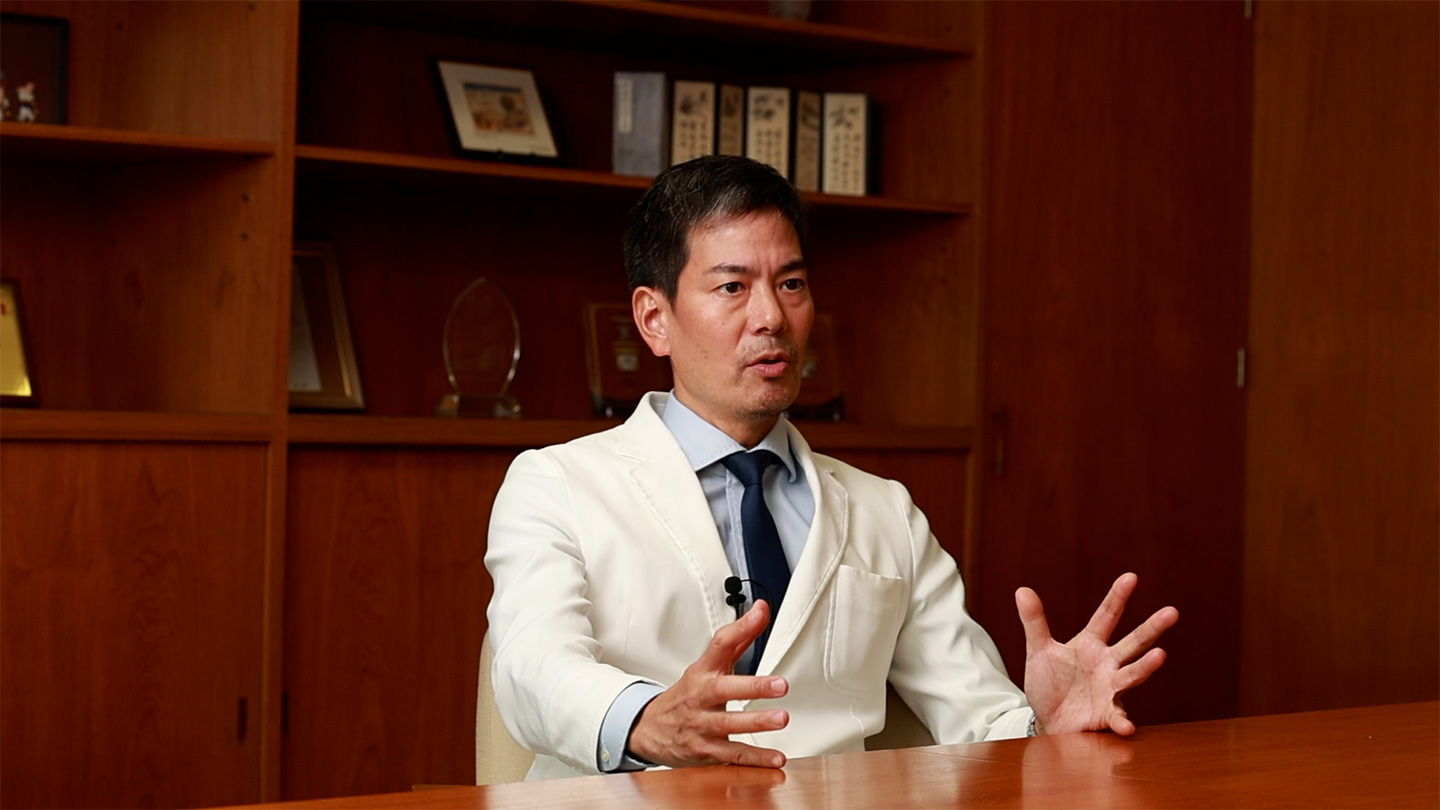
Osaka, once a place with no ties for me, is now becoming a home.
NAKAZAWA’s first impression of Kindai University Faculty of Medicine was simple: “Everyone here is genuinely kind.”“The first thing I was told was to strengthen and revitalize the department’s clinical practice. What I always say during conferences and discussions is that the patient comes first. We must never practice medicine for the sake of our own ambition.”
In recent years, when it comes to cardiovascular diseases—particularly heart-related conditions—the term “heart team” has become widely used. Coronary artery disease, valvular heart disease, aortic disease: for each of these diseases around the heart, numerous treatment options are available. Catheter-based procedures such as PCI and TAVI/TAVR, medical therapies, and drug treatments all need to be weighed carefully to find the optimal solution for each patient’s condition. To do so requires close collaboration between cardiologists and cardiovascular surgeons, as well as anesthesiologists, radiologists, nurses, and rehabilitation staff.
At Kindai University, NAKAZAWA now leads this heart team alongside SAKAGUCHI, who first invited him. Their partnership remains strong.
“The number of cardiovascular surgeons is already small, and it keeps shrinking. If there aren’t enough people who can actually perform surgery, both we and our patients will be in trouble. That’s why it’s absolutely vital to protect the mental and physical health of the surgeons. So, starting in 2025, we decided to exempt them from night duty, with us cardiologists taking on that coverage. After all, when emergency surgeries arise, they may have to operate through the night. It’s a relationship of mutual support—give and take,” NAKAZAWA explains.
Since 2021, NAKAZAWA has served two terms as Director of the Emergency and Disaster Medical Center. To fill the previously vacant chair in emergency medicine, he personally recruited SHINOZAKI Koichiro, the current professor and chair. This time, it was NAKAZAWA’s turn to reach out through his network.
Though he had once had no ties to Osaka, he now finds it steadily becoming home.
“I’m also serving as Deputy Director of Kindai University Hospital. With relocation to a new hospital on the horizon, I feel a responsibility to build strong teams and help raise Kindai University’s brand,” he says.
NAKAZAWA’s guiding principle is clear: to boldly keep moving forward toward whatever challenge or goal lies directly before him. He remains unwaveringly focused on the future.